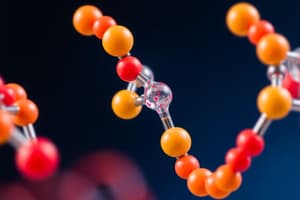Podcast
Questions and Answers
Classify the description as pertaining to nucleosides, nucleotides, or both nucleosides and nucleotides.
Classify the description as pertaining to nucleosides, nucleotides, or both nucleosides and nucleotides.
- Nucleosides (correct)
- Both (correct)
- Nucleotides (correct)
What is the DNA sequence complementary to AGTC?
What is the DNA sequence complementary to AGTC?
TCAG
Classify the statements as describing deoxyribonucleic acid (DNA) or ribonucleic acid (RNA).
Classify the statements as describing deoxyribonucleic acid (DNA) or ribonucleic acid (RNA).
- DNA (correct)
- RNA (correct)
What intermolecular force is responsible for holding the two strands of a DNA double helix together?
What intermolecular force is responsible for holding the two strands of a DNA double helix together?
What is a phosphodiester bond?
What is a phosphodiester bond?
Which DNA molecule has a lower percentage of G-C base pairs that stabilize DNA duplexes?
Which DNA molecule has a lower percentage of G-C base pairs that stabilize DNA duplexes?
How does the structure of DNA encode genetic information?
How does the structure of DNA encode genetic information?
What are the stabilizing factors that hold the two strands of DNA together in a double helix?
What are the stabilizing factors that hold the two strands of DNA together in a double helix?
In Watson-Crick base pairing in DNA, guanine pairs with?
In Watson-Crick base pairing in DNA, guanine pairs with?
The phosphate groups are on the outside of the DNA double helix because they are charged and interact with the aqueous environment surrounding the DNA.
The phosphate groups are on the outside of the DNA double helix because they are charged and interact with the aqueous environment surrounding the DNA.
What contribution did James Watson and Francis Crick make to our understanding of DNA?
What contribution did James Watson and Francis Crick make to our understanding of DNA?
Choose the statement that explains why organisms use DNA as the central repository for genetic information.
Choose the statement that explains why organisms use DNA as the central repository for genetic information.
Match the structure names to the descriptions given.
Match the structure names to the descriptions given.
What is small nuclear RNA?
What is small nuclear RNA?
What is ribosomal RNA?
What is ribosomal RNA?
What is transfer RNA?
What is transfer RNA?
What is small interfering RNA?
What is small interfering RNA?
What is messenger RNA?
What is messenger RNA?
What is micro RNA?
What is micro RNA?
In bacteria, which two bases undergo methylation more often?
In bacteria, which two bases undergo methylation more often?
What are the functions of nucleic acids?
What are the functions of nucleic acids?
What are the functions of nucleotides?
What are the functions of nucleotides?
What are the components of a nucleotide?
What are the components of a nucleotide?
What are the components of a nucleoside?
What are the components of a nucleoside?
What is a phosphate group?
What is a phosphate group?
What is a nitrogenous base?
What is a nitrogenous base?
What are minor nucleosides in DNA?
What are minor nucleosides in DNA?
What is inosine?
What is inosine?
What is pseudouridine?
What is pseudouridine?
What are prototropic tautomers?
What are prototropic tautomers?
Where is keto-enol tautomerism common?
Where is keto-enol tautomerism common?
Where does lactam-lactim tautomerism occur?
Where does lactam-lactim tautomerism occur?
What are polynucleotides?
What are polynucleotides?
How are covalent bonds formed?
How are covalent bonds formed?
Is the DNA backbone stable?
Is the DNA backbone stable?
Is the RNA backbone unstable?
Is the RNA backbone unstable?
What is meant by linear polymers?
What is meant by linear polymers?
What is hydrolysis of RNA?
What is hydrolysis of RNA?
What are hydrogen bonding interactions?
What are hydrogen bonding interactions?
What is replication of genetic code?
What is replication of genetic code?
What is a beta-N-glycosidic bond?
What is a beta-N-glycosidic bond?
What is conformation around N-Glycosidic Bond?
What is conformation around N-Glycosidic Bond?
What is DNA denaturation?
What is DNA denaturation?
What are factors affecting DNA denaturation?
What are factors affecting DNA denaturation?
What are applications of near-complementary hybrid in DNA and RNA?
What are applications of near-complementary hybrid in DNA and RNA?
What is deamination?
What is deamination?
What is depurination?
What is depurination?
What is oxidative damage?
What is oxidative damage?
What is chemical alkylation?
What is chemical alkylation?
What are molecular mechanisms of radiation-induced mutagenesis?
What are molecular mechanisms of radiation-induced mutagenesis?
Flashcards
What is a nucleoside?
What is a nucleoside?
A nucleoside is a building block of nucleic acids, consisting of a nitrogenous base (adenine, guanine, cytosine, thymine, or uracil) attached to a pentose sugar (ribose or deoxyribose).
What is a nucleotide?
What is a nucleotide?
A nucleotide is a building block of nucleic acids, composed of a nitrogenous base, a pentose sugar, and a phosphate group.
What is complementary base pairing?
What is complementary base pairing?
Complementary base pairing in DNA involves the specific pairing of adenine (A) with thymine (T) and cytosine (C) with guanine (G) through hydrogen bonds. The complementary base pairing ensures accurate DNA replication and transcription.
What is DNA?
What is DNA?
Signup and view all the flashcards
What is RNA?
What is RNA?
Signup and view all the flashcards
How do hydrogen bonds contribute to DNA structure?
How do hydrogen bonds contribute to DNA structure?
Signup and view all the flashcards
What is a phosphodiester bond?
What is a phosphodiester bond?
Signup and view all the flashcards
What is base stacking in DNA?
What is base stacking in DNA?
Signup and view all the flashcards
What happens during DNA denaturation?
What happens during DNA denaturation?
Signup and view all the flashcards
What is the melting temperature (Tm) of DNA?
What is the melting temperature (Tm) of DNA?
Signup and view all the flashcards
What are hairpin loops?
What are hairpin loops?
Signup and view all the flashcards
What are G-quadruplexes?
What are G-quadruplexes?
Signup and view all the flashcards
What are cruciform structures?
What are cruciform structures?
Signup and view all the flashcards
What is triplex DNA?
What is triplex DNA?
Signup and view all the flashcards
What is DNA methylation?
What is DNA methylation?
Signup and view all the flashcards
What is mRNA?
What is mRNA?
Signup and view all the flashcards
What is tRNA?
What is tRNA?
Signup and view all the flashcards
What is rRNA?
What is rRNA?
Signup and view all the flashcards
What is inosine?
What is inosine?
Signup and view all the flashcards
What is pseudouridine?
What is pseudouridine?
Signup and view all the flashcards
What is tautomerism?
What is tautomerism?
Signup and view all the flashcards
What are prototropic tautomers?
What are prototropic tautomers?
Signup and view all the flashcards
What is keto-enol tautomerism?
What is keto-enol tautomerism?
Signup and view all the flashcards
What is lactam-lactim tautomerism?
What is lactam-lactim tautomerism?
Signup and view all the flashcards
What is a polynucleotide chain?
What is a polynucleotide chain?
Signup and view all the flashcards
What is deamination?
What is deamination?
Signup and view all the flashcards
What is depurination?
What is depurination?
Signup and view all the flashcards
What is alkylation?
What is alkylation?
Signup and view all the flashcards
What is oxidative damage to DNA?
What is oxidative damage to DNA?
Signup and view all the flashcards
What is antisense therapy?
What is antisense therapy?
Signup and view all the flashcards
What are fluorescent DNA chips?
What are fluorescent DNA chips?
Signup and view all the flashcards
Study Notes
Nucleic Acids: Structure and Function
- Nucleosides consist of a base and a pentose sugar, while nucleotides contain a phosphate group in addition to the base and sugar.
- DNA sequences can be complementary, with A pairing with T and C pairing with G.
- DNA is typically double-stranded and stable, while RNA is mostly single-stranded and more susceptible to hydrolysis.
Intermolecular Forces and Bonding
- Hydrogen bonds stabilize the DNA double helix structure.
- Phosphodiester bonds form the sugar-phosphate backbone, linking nucleotides covalently.
- Base stacking and hydrophobic interactions further stabilize DNA double helices.
DNA Structural Variations
- Sequence-dependent variations, such as hairpin, G-quadruplex, cruciform, and triplex structures, can influence DNA's function.
- Methylation of adenine and cytosine bases commonly occurs in bacteria, serving as an epigenetic marker.
Nucleic Acid Types and Functions
- Nucleic acids have various functional roles: DNA stores genetic information, mRNA transmits information, tRNA and rRNA are involved in protein synthesis.
- Minor nucleosides like inosine and pseudouridine play crucial roles in genetic code diversity and RNA stability.
Tautomerism and Stability
- Prototropic tautomers are structural isomers with differing proton locations; common in nucleotide bases.
- Keto-enol and lactam-lactim tautomerism can affect nucleotide stability and interactions.
Generating and Modifying Nucleic Acids
- Covalent bonds through phosphodiester linkages form polynucleotide chains, critical for genetic information replication.
- DNA denaturation involves breaking hydrogen bonds, leading to increased UV absorbance, which can be reversible under certain conditions.
Mutagenesis and Genetic Integrity
- Deamination and depurination represent common forms of DNA damage, with significant consequences for genetic stability.
- Chemical alkylation and oxidative damage can modify DNA bases, influencing mutation rates linked to aging and diseases such as cancer.
Applications and Techniques
- Near-complementary hybrids in DNA and RNA are used in detecting specific sequences and amplifying DNA via techniques like PCR.
- Antisense therapy and fluorescent DNA chips utilize hybridization methods for therapeutic and research applications.
Key Terminology
- Nucleoside: Base + Pentose Sugar.
- Nucleotide: Nucleoside + Phosphate.
- TM (Melting Temperature): Higher with more G-C pairs or longer DNA sequences.
- Hydrogen Bonding: Pairs bases in DNA; crucial for duplex stability.
- RNA Hydrolysis: Mostly unstable due to its structure, leading to rapid degradation.
Studying That Suits You
Use AI to generate personalized quizzes and flashcards to suit your learning preferences.



